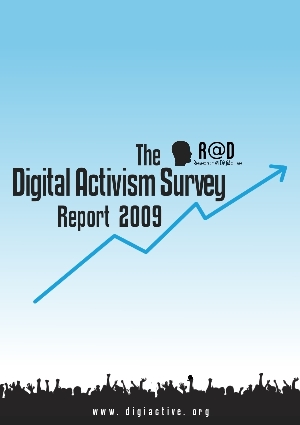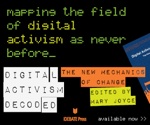Colleagues Mary Joyce, Timo Zaeck and myself have just released the findings of a study on Digital Activism around the world through DigiActive’s Research@DigiActive (R@D).
To download the full report click here (in .pdf format):
Abstract:
Our goal in creating this survey was to collect the first international demographic data on the new group we call “digital activists”: people who use digital technology as part of grassroots campaigns for social and political change.
From late mid-February to mid-April of 2009, DigiActive collected 122 responses through an open online form, followed by three rounds of qualitative and quantitative analysis. Despite the challenges of researching the world’s digital activists we felt a need to record - in some rough way - this evolving demographic. Our original data set is available for download above and we welcome comments below through [email protected].
Key Findings:
Economics Digital activists, particularly in developing countries, are much more likely than the population at large to pay a monthly subscription fee to have Internet at home, to be able to afford a high-speed connection, and to work in a white-collar job where Internet is also available. In short, digital activists are likely to be prosperous.
Access Intensity of use, rather than simple access, is critical as to whether or not a person is a digital activist. This high use is only possible for people with the ability to pay for it. The Internet may be democratizing, but its effects are felt most strongly in the global middle class.
Causes Across regions, “rights” emerged as the most popular cause, with 21 different types identified by respondents.
Broadcast The plurality of respondents (37%) believe digital technology’s greatest value for activism is one-way communication. What makes social media useful for digital activism may not be its interactivity but rather the fact that these technologies collapse the barrier to broadcast.
Mobiles Respondents with more features on their mobile phone - such as Internet, video, and GPS - are more likely to use their phones for activism. This is another indicator of the importance of financial resources for digital activists, both quantitatively, in terms of greater technology access, and qualitatively, in terms of better (mobile) hardware.
Platforms Social networks are the most common “gateway drug” into digital activism.
Skills Findings on technology and advocacy skills acquisition challenge the assumption that those who have a facility with technology are more likely to become digital activists and gives encouragement to programs that seek to teach technology skills to traditional activists.
Age Older activists in the respondent group are most likely to use digital technology to increase the efficiency of offline activities, such as training and evidence collection, and less likely to participate in activities which have gained popularity because of the availability of online tools, such as posting original content on web sites.
The purpose of Research@DigiActive (R@D) is to produce applied, thought-provoking, actionable research at the cutting edge of Digital Activism. It seeks to highlight and disseminate studies in the new academic field of digital activism by publishing short papers by promising scholars. To submit a paper or get more information, please contact our Director of Applied Research, Patrick Meier, at Patrick AT Digiactive.org.
Related articles by Zemanta
- R@D: Mobile Phones as a Tool for Civil Resistance - Case Studies from Serbia and Belarus (digiactive.org)
- R@D: Mobile Activism in African Elections - a Comparative Case Study (digiactive.org)
- Social Actions + DigiActive: Facebook chat (digiactive.org)








